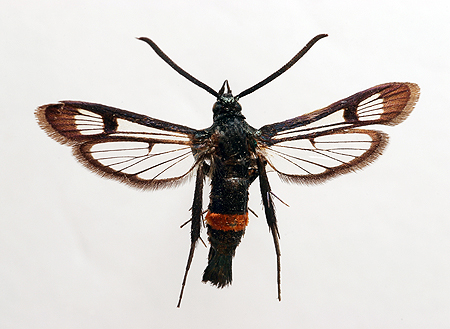Pests
Synanthedon myopaeformis (Borkhausen) - Red-belted Clearwing, Small Red-belted Clearwing, Apple Clearwing, Apple Borer
Systematic position.
Class Insecta, order Lepidoptera, family Aegeriidae, genus Synanthedon.Synonym:
Aegeria myopaeformis (Borkh.)Biological group.
This is a monophagous pest of apple trees.Morphology and biology.
Wings transparent, hyaline, with bluish-black scales along margins and veins (wingspan 18-22 mm). Palpi black, in male white on inner side. Fourth abdominal ring is red, in female with white ventral stripe in the middle. Abdominal apex is black, in male yellow in the middle. Caterpillar is light-yellow, with reddish tint. Body has a reddish transparent longitudinal dorsal line, with thin sparse lateral hairs. Head reddish-brown. Spiracles black. Occipital plate is dark, reddish-brown, without painted grooves. Anal plate is not sharply projecting, having almost the same coloring as body segments. Pupa is brown-yellow, with 2 small tubercles on head and 2 dorsal rows of spinules on abdominal segments. Caterpillars of 1st and 2nd years of life winter in holes under bark. In spring the caterpillars gnaw out bark toward living tissue and make twisting holes upward, filling cavities with wood dust mixed with excrements and plant juice. This mixture protrudes out of wound apertures as small brownish heaps. Twice wintered caterpillars pupate rapidly in dense silky cocoons. Before pupation the caterpillar gnaws away an additional hole directed toward bark surface and terminating by flight outcome covered with a thin layer of bark. The pupa stage lasts about 2 weeks. Right before moth appearance the pupa moves toward flight outcome with the help of body spinules, projecting approximately half of its body. Female lays about 200-250 eggs one by one on trunks and thick branches in cracks or under bark scales.Distribution.
The species inhabits middle and southern Europe, Asia Minor and Northern Africa. In the former USSR it is distributed in forest-steppe and steppe zones of the European part (middle belt and the south) to Volga River, in the Caucasus, Transcaucasia, Ukraine everywhere. Its potential area in the north reaches the central Sweden and the south Pskov Region (Russia).Ecology.
Development of the species is biennial, but annual in conditions of dry subtropics (Azerbaijan, Crimea). In spring the caterpillars continue feeding from the beginning of bud blossoming of fruit crops, making new holes where they winter the second time. In the Krasnodar Territory their feeding begins at the end of the last 3rd of March and in the beginning of April which coincides with the beginning of tree sap circulation. Moth flight lasts from the end of May until the end of August. Moths are thermophilic; their flight activity is reduced sharply on cloudy cold days. The flight stops with an daily average air temperature of 15-16°C. Delayed oviposition causes heterochrony of aging in population. Caterpillars of different ages are found simultaneously in nature. Caterpillars of the same age develop during different vegetation periods of trees. In autumn they stop feeding during cold weather and winter in holes.Economic significance.
The species is a significant pest of fruit trees, mainly apple trees, less often pears, plums, cherries, mountain ashes, hawthorn, apricot. Sometimes it occupies up to 30-50% of trees. Old plantations are usually populated by the pest, having trees that are affected by fungal diseases or damaged physically. Gnawing holes in living tissue, the caterpillars break the normal process of nutrient supply to the tree, causing death and scaling of bark. It results loss of vigor, and later trees can die. The affected trees can be identified by projecting exuvia. Control measures include autumn cleaning and whitewashing of trunks; spring plastering of the damaged trunks and main branches with clay and lime; cleaning of scaling bark during winter thaws with a subsequent insecticide spraying at daily average temperature +4-5°C; insecticide treatments of fruit trees during moth flight and oviposition.Reference citations:
Baryakin A.A. 1967. Some features of biology of Aegeria myopaeformis Borkh. (Lepidoptera, Aegeriidae) in Azerbaijan. Entomologicheskoe obozrenie 46(3): 606-614. (In Russian)Savkovskii P.P. 1976. Atlas of the pests of fruit and berry plants. Kiev: Urozhai. 207 p. (In Russian)
Sukhareva I.L. 1994. Sesiidae (Aegeriidae). In: Kuznetsov V.I., ed. Insects and mites - pests of agricultural plants. V. 3(1). Lepidoptera. St. Petersburg: Nauka. 44-47 p. (In Russian)
Vasil.ev V.P., Livshits I.Z. 1984. Pests of fruit crops. Moscow: Kolos. 399 p. (In Russian)
Zagaikevich I.K. 1974. Aegeriidae. In: Vasil.ev V.P., ed. Pests of agricultural crops and forest plantations. V. 2. Arthropods. Kiev: Urozhai. 250-256 p. (In Russian)


